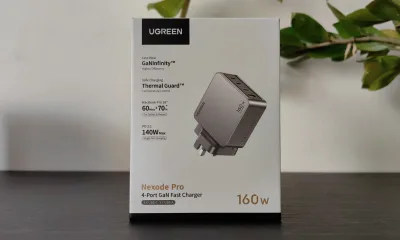Components
Details for Intel’s Core i9 Processor Lineup Revealed
Intel is finally ready to share full specifications for its higher-end Core i9 (Skylake-X) processors, including its flagship Core i9-7980XE, an Extreme Edition chip with 18 physical cores and 36 threads.
Up until this point, Intel had only revealed speeds and feeds for its Core X-series up through the Core i9-7900X, a $1,000 10-core/20-thread CPU clocked at 3.3GHz to 4.3GHz (4.5GHz via Turbo Max 3.0). Intel listed higher-end processor options as part of its Skylake-X lineup, but only shared core/thread counts and pricing. Now we have details for the entire lineup:
The Core i9-7980XE features a 2.6GHz base clockspeed. That’s not terribly exciting, though we’re not real concerned with base clocks since Intel’s chips do a good job of hitting Turbo clocks as needed. In that regard, the Core i9-7980XE has a Turbo clock of 4.2GHz, and can hit 4.4GHz in single-threaded workloads. Those are both 100MHz lower than the maximum we’ve seen on Skylake-X, which is good to see.
The Core i9-7980XE will also have 24.75MB of L3 cache, the most of any Core X-series chip, along with 44 PCIe lanes and a 165W TDP. Of course, you have to pay to play in the deep end—in this case, the asking price is $1,999.
Moving down the list, Intel also filled in the blanks for its Core i9-7920X, Core i9-7940X, and Core i9-7960X processors. Turbo clocks are pretty consistent throughout the entire Core i9 family, which means that real-world performance will largely depend on how well an application takes advantage of multiple cores and threads.
These are all unlocked processors, meaning buyers will be able to try and push clockspeeds higher than Intel’s official specifications. That said, we don’t anticipate there being a ton of headroom on the Core i9-7980XE, at least compared to the CPUs that sit underneath it.
But the above slide only gives the base and maximum Turbo Boost clockspeeds. The complete official ‘stock’ clocks for various core loads are arguably more important, and Intel provided us with that data as well. Here are the core load Turbo Boost 2.0 clocks for the full line of Skylake-X parts, for reference:
Intel is planning to release the Core i9-7920X on August 28. The Core i9-7940X, Core i9-7960X, and Core i9-7980XE will be available starting September 25.

Components
TEAMGROUP Launches the MP44Q M.2 PCIe 4.0 SSD

Team Group has launched TEAMGROUP MP44Q M.2 PCIe 4.0 Solid State Drive, featuring the latest 3D QLC NAND technology, combining cutting-edge technology with the trend of demanding high storage capacity to meet daily system and file storage needs. TEAMGROUP MP44Q M.2 PCIe 4.0 SSD utilises the latest 3D QLC NAND, offering capacities of up to 4TB. With the PCIe Gen4 x4 interface and SLC Caching technology, it achieves maximum sequential read and write speeds of up to 7,400 MB/s and 6,500 MB/s, respectively.
The MP44Q SSD operates with low power consumption, catering to all document processing and storage applications, significantly enhancing work efficiency. Paired with TEAMGROUP’s exclusively patented graphene heat dissipation sticker, whose thickness is less than 1 mm, eliminating the potential for mechanical interference in any assembly, coupled with the native heat sink of the motherboard, such an arrangement effectively addresses the heat generated by high performance, extending the SSD’s lifespan.
Additionally, it supports TEAMGROUP’s exclusively patented SSD intelligent monitoring software, S.M.A.R.T., allowing for quick and easy configuration and testing, effortlessly monitoring the quality and performance of the SSD. The product also provides the latest QLC high-speed Gen4 x4 SSD to cater to various storage needs for both life and work.
The packaging of TEAMGROUP MP44Q M.2 PCIe 4.0 SSD adopts recyclable packaging materials and has passed RoHS, REACH, and other environmental protection certifications with the effort of contributing to sustainable living. The product comes with a comprehensive 5-year warranty, ensuring consumer confidence in product quality. It is expected to be available globally starting in early May 2024.
Components
Gigabyte Unveils Limited Edition “Ice” Themed Motherboard and GPU

Gigabyte has officially launched its long-awaited XTREME Prestige Limited Edition lineup, featuring a visually stunning and overclocked RTX 4080 SUPER graphics card and a feature-packed Z790 motherboard. Both components boast a luxurious titanium and gold design, complete with unique engraved serial numbers, hinting at the limited production run – estimated between 300 and 500 units.
The centrepiece, the Aorus GeForce RTX 4080 Super Xtreme Ice 16G, boasts a factory overclock of 150 MHz and improved performance over the stock model. Gigabyte claims it delivers 885 AI TOPs compared to the stock card’s 836. Cooling this beast are three massive “bionic shark” fans and a large vapour chamber. For those seeking ultimate customization, the fans feature addressable RGB rings, and the card itself sports an LCD monitor displaying customizable GIFs.
The Z790 Aorus Xtreme X Ice motherboard complements the graphics card perfectly. It boasts a unique crystalized titanium finish, a golden CPU socket, and a removable M.2 heatsink. Feature-wise, it supports DDR5 memory with speeds exceeding XMP-8266 and offers AI-powered CPU overclocking, promising speeds exceeding 6.3 GHz on an i9-14900KS. An included external DAC further boosts audio quality.
While pricing remains a mystery (promised on the Gigabyte website but currently unavailable), expect a hefty price tag, likely exceeding $1,299 for the graphics card alone. Both products will be sold separately, but a future bundle with additional Xtreme Ice components is a possibility.
Gigabyte promises a luxurious “unboxing experience” for each component, complete with premium packaging, high-end tools, and even anti-static gloves. We’ll update this story with confirmed pricing when available.
Components
CORSAIR Intros White RMx SHIFT PSU Series with Side-Mounted Connection

CORSAIR today launched a white colour variant of the revolutionary RMx SHIFT Series of ATX 3.0 power supplies. RMx SHIFT, the world’s first PSU with the DC connector panel on the side of the unit, quickly became a sensation among DIY PC enthusiasts after its launch last year thanks to cleaner and easier cabling than traditional power supplies. Available in 750, 850, 1000, and 1200 wattages, the RMx SHIFT Series exemplifies CORSAIR’s commitment to addressing the evolving needs of its customers.
With its repositioned side panel, builders have unobstructed access to all of its Type 5 Gen 1 micro-fit connections, making installation and maintenance painless. It also means less bending and twisting of the cables, removing unnecessary strain on the cables and connectors.

White models of RMx SHIFT address the overwhelming demand from the PC building community for more customization options to match a wider range of builds. The new white units retain all the features that have made the RMx SHIFT a market standout, including fully modular cabling, 80 Plus Gold-rated efficiency, premium 105°C-rated Japanese capacitors, and a 140 mm fluid dynamic bearing fan, while matching the clean aesthetic of white system builds.

With ATX 3.0 certification and PCIe 5.0 compliance, the RMx SHIFT Series is ready to power the latest systems and includes a PCIe 5.0 12VHPWR GPU cable for use with modern graphics cards such as the NVIDIA GeForce RTX 40 Series. RMx SHIFT PSUs and cables will fit in any PC case that supports the ATX format and is at least 210 mm (8.3″) wide. The PSU must also be accessible from the side when mounted in the case.
The CORSAIR RMx SHIFT White series is available now from the CORSAIR webstore and the CORSAIR worldwide network of authorised retailers and distributors. The RMx SHIFT Series is backed by a ten-year warranty, alongside the CORSAIR worldwide customer service and technical support network.





















